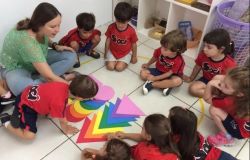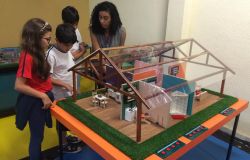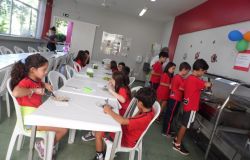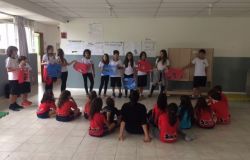How is SACI's Bilingual Program:
According to the studies by Stephen Krashen (1998), the acquisition of the English language is a natural process, similar to the way we learn our mother language. We communicate in a natural way about subjects according to our experiences and needs. Thus, the principles of our bilingual program focus on three pillars, which are: the use of the target language at all times; the subjects and themes in the teaching environment are focused on the learner’s interest; the teachers make several attempts to make themselves understood.
Additionally, the work with projects, which is based on the studies of Fernando Hernández (1998), is placed as a bridge for the acquisition of the English language because when students have the chance to choose the subject of their studies, they feel more motivated to express themselves by using the second language. Therefore, our classes aim to to encourage learners to express their ideas, opinions, desires, and feelings. Moreover, they represent an environment of good relations between colleagues and teachers, factors that are necessary for the acquisition of the second language to happen.
In the natural approach, the development of the ability to understand - listening and reading, precedes the practice of production - speaking and writing. Krashen (1998) identifies four stages that outline the path for the acquisition of the second language, which are mentioned below:
PERIOD OF SILENCE: It can last for a few hours or months. Language comprehension begins, but the student still does not feel safe to speak or repeat words and phrases. The understanding of the first commands in English is expressed by the response with body language.
PRE PRODUCTION PERIOD: Moment of producing short words (yes; no; house; dog, etc.). Comprehension skills are under development, but more complex issues can still be difficult to understand.
EARLY PRODUCTION PERIOD: Marked by the student's attempts to formulate autonomous phrases and questions, that is, combinations of two or three words (paper on table; where book? Etc.). Such phrases and questions can often be “patterns” memorized by continuous use (what’s your name?) However, they still encourage the learner to keep on taking risks. At this stage, there is not much focus on grammar correction, but rather on the transmission of the learner's message.
PRODUCTION PERIOD: The learner can spontaneously produce phrases and questions (I want to stay; the boy running etc.) in the second language. Subsequently, their evolution is everlasting, being able to take part in conversations, discussions, more complex games, and group work. At this stage, there is still the presence of ungrammatical phrases in the speech and, therefore, there is greater focus on correction.
Such periods are observed by the teacher in the apprentice and their interactions throughout the year. For this reason, students receive a report concerning the teacher's observations about the child and his/her stage in the development of English language acquisition.
We must also pay attention to two facts. First, these four stages are unrelated to the apprentice's age. Hence, we organize the classes in the Bilingual Program based on the same principles as the regular classes, which are age group and Montessori development plan. Second, according to the natural acquisition of the second language, for a speaker that still has little knowledge to understand what is spoken, it is necessary that the professor focus on the context and gather exposure to extralinguistic information, such as images and videos. That said, for the child who has just been introduced to the environment of the second language to have an initial understanding, the teacher will use different resources and make themselves understood through the level of the second language that is in the domain of his student.
Bilingual education the virtual environment
Given the present scenario, there are many doubts about the effectiveness of teaching English online to children and adolescents. We have observed, since March 2020, when this new modality began, the notorious development of listening and reading skills. We credit this evolution to the advancement of the student's ability to concentrate, supported by the use of earphones to understand what is said by the teacher and what is presented in videos, music and especially in online interviews in real time, which simplify the participation of people from anywhere in the world.
If in person there is interference from conversations and other “distractors”, in the virtual environment we can see that interference does not occur, what provides greater concentration. However, the motivation and engagement that arise naturally in face-to-face interactions also boosting learning, have our attention during online classes.
Regarding the development of speaking and writing, we are favored by the average number of 13 students in our classes, which means that even in the virtual environment the teacher can listen and give the necessary attention to one student at a time. The dynamics and interactivity of the classes happen through didactic games that contribute to the development of vocabulary and formation of sentences; cooking classes help with specific vocabulary about culinary and food, in addition to preparing children for everyday activities; watching and listening to videos and music related to the themes of the projects grant to great motivation; yet, research and presentations related to the new discoveries of the projects are practices that contribute to increasingly autonomous and fluent students.
In conclusion, studies on the acquisition process show that the learner needs to feel comfortable in their learning environment either formal or informal. Therefore, they should not be forced to use the targuet language if they do not feel prepared. Furthermore, as there is no great grammatical precision in the initial stages, it is not necessary to correct all ungrammatical productions, that is, those that do not interfere in the understanding of the discourse.
However, it is favoring for the child to be surrounded by inputs that are elements that bring the English language into their daily life, for instance, films, music, books, drawings, games, etc. This way, we will have learners accustomed to the second language in a natural way, what will result in children who are motivated and pleased to be able to live the culture of their second language and to use English in real moments of speech, in other words, students who are trully because bilingual.
*Krashen, S.D.; Terrell, T.D. 1998. The natural approach: language acquisition in the classroom. Prentice Hall ELT, Hertfordshire, England, UK. Disponível em <http://www.sdkrashen.com/content/books/the_natural_approach.pdf > Acesso em 16 de Fevereiro de 2021
*Hernández, P. 1998. Transgressão e mudança na educação. Os projetos de trabalho. 5ed. Artmed S.A, Porto Alegre, RS, Brasil.







